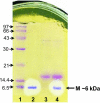Isolation of a Lactobacillus salivarius strain and purification of its bacteriocin, which is inhibitory to Campylobacter jejuni in the chicken gastrointestinal system
- PMID: 16940109
- PMCID: PMC1563535
- DOI: 10.1128/AAC.00259-06
Isolation of a Lactobacillus salivarius strain and purification of its bacteriocin, which is inhibitory to Campylobacter jejuni in the chicken gastrointestinal system
Abstract
We evaluated anti-Campylobacter jejuni activity among >1,200 isolates of different lactic acid bacteria. Lactobacillus salivarius strain NRRL B-30514 was selected for further study. The cell-free, ammonium sulfate precipitate from the broth culture was termed the crude antimicrobial preparation. Ten microliters of the crude preparation created a zone of C. jejuni growth inhibition, and growth within the zone resumed when the crude preparation was preincubated with proteolytic enzymes. Bacteriocin OR-7, derived from this crude preparation, was further purified using ion-exchange and hydrophobic-interaction chromatography. The determined amino acid sequence was consistent with class IIa bacteriocins. Interestingly, OR-7 had sequence similarity, even in the C-terminal region, to acidocin A, which was previously identified from L. acidophilus and had activity only to gram-positive bacteria, whereas OR-7 had activity to a gram-negative bacterium. Bacteriocin activity was stable following exposure to 90 degrees C for 15 min, also consistent with these types of antibacterial peptides. The purified protein was encapsulated in polyvinylpyrrolidone and added to chicken feed. Ten day-of-hatch chicks were placed in each of nine isolation units; two groups of birds were challenged with each of four C. jejuni isolates (one isolate per unit). At 7 days of age, one group of birds was treated with bacteriocin-emended feed for 3 days, and one group was left untreated. At 10 days of age, the birds were sacrificed and the challenge strain was enumerated from the bird cecal content. Bacteriocin treatment consistently reduced colonization at least one millionfold compared with levels found in the untreated groups. Nonchallenged birds were never colonized by C. jejuni. Bacteriocin from L. salivarius NRRL B-30514 appears potentially very useful to reduce C. jejuni in poultry prior to processing.
Figures


Similar articles
-
Paenibacillus polymyxa purified bacteriocin to control Campylobacter jejuni in chickens.J Food Prot. 2005 Jul;68(7):1450-3. doi: 10.4315/0362-028x-68.7.1450. J Food Prot. 2005. PMID: 16013385
-
Isolation of Lactobacillus salivarius 1077 (NRRL B-50053) and characterization of its bacteriocin, including the antimicrobial activity spectrum.Appl Environ Microbiol. 2011 Apr;77(8):2749-54. doi: 10.1128/AEM.02481-10. Epub 2011 Mar 4. Appl Environ Microbiol. 2011. PMID: 21378051 Free PMC article.
-
Isolation of Bacillus circulans and Paenibacillus polymyxa strains inhibitory to Campylobacter jejuni and characterization of associated bacteriocins.J Food Prot. 2005 Jan;68(1):11-7. doi: 10.4315/0362-028x-68.1.11. J Food Prot. 2005. PMID: 15690798
-
Purification and characterization of a new bacteriocin active against Campylobacter produced by Lactobacillus salivarius SMXD51.Food Microbiol. 2012 Oct;32(1):129-34. doi: 10.1016/j.fm.2012.05.002. Epub 2012 May 27. Food Microbiol. 2012. PMID: 22850384
-
The Potential of Lactic Acid Bacteria and Dairy By-Products in Controlling Campylobacter jejuni in Poultry.Microorganisms. 2025 Apr 26;13(5):996. doi: 10.3390/microorganisms13050996. Microorganisms. 2025. PMID: 40431169 Free PMC article. Review.
Cited by
-
Caecal microbiota compositions from 7-day-old chicks reared in high-performance and low-performance industrial farms and systematic culturomics to select strains with anti-Campylobacter activity.PLoS One. 2020 Aug 24;15(8):e0237541. doi: 10.1371/journal.pone.0237541. eCollection 2020. PLoS One. 2020. PMID: 32834007 Free PMC article.
-
Campylobacter jejuni in Poultry: Pathogenesis and Control Strategies.Microorganisms. 2022 Oct 28;10(11):2134. doi: 10.3390/microorganisms10112134. Microorganisms. 2022. PMID: 36363726 Free PMC article. Review.
-
Response of porcine intestinal in vitro organ culture tissues following exposure to Lactobacillus plantarum JC1 and Salmonella enterica serovar Typhimurium SL1344.Appl Environ Microbiol. 2010 Oct;76(19):6645-57. doi: 10.1128/AEM.03115-09. Epub 2010 Jul 16. Appl Environ Microbiol. 2010. PMID: 20639369 Free PMC article.
-
Advances in Campylobacter biology and implications for biotechnological applications.Microb Biotechnol. 2010 May;3(3):242-58. doi: 10.1111/j.1751-7915.2009.00118.x. Epub 2009 May 19. Microb Biotechnol. 2010. PMID: 21255325 Free PMC article. Review.
-
New and alternative strategies for the prevention, control, and treatment of antibiotic-resistant Campylobacter.Transl Res. 2020 Sep;223:76-88. doi: 10.1016/j.trsl.2020.04.009. Epub 2020 May 11. Transl Res. 2020. PMID: 32438073 Free PMC article. Review.
References
-
- Bhunia, A. K., M. C. Johnson, and B. Ray. 1987. Direct detection of an antimicrobial peptide of Pediococcus acidilactici in sodium dodecyl sulfate-polyacrylamide gel electrophoresis. J. Ind. Microbiol. 2:319-322.
-
- Cleveland, J., T. J. Montville, and M. L. Chikindas. 2001. Bacteriocins: safe food preservatives of the future. Int. J. Food Microbiol. 71:1-20. - PubMed
-
- Cotter, P. D., C. Hill, and R. P. Ross. 2005. Bacteriocins: developing innate immunity for food. Nat. Rev. Microbiol. 3:777-788. - PubMed
Publication types
MeSH terms
Substances
LinkOut - more resources
Full Text Sources
Other Literature Sources
Medical
Molecular Biology Databases

